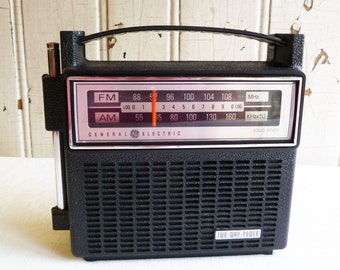


Other collectible American-made radios are from RCA, G.E., Admiral, Motorola, Magnavox, Philco, Raytheon, Arvin, Sylvania and Emerson etc. An early handwired 500 will fetch more money than the later versions. If you’re into high performance you may want to consider this one.
#Ge transistor radio vintage portable
It has a large oval speaker and is considered to be the best sounding/performing portable transistor radio ever. The first Royal 500 was hand wired and had a metal chassis! The fifth generation Zenith 500 was the 500H.
#Ge transistor radio vintage series
The TR-1 and TR-1G used an odd 22.5 volt battery which can be found in limited quantities today but are pricey.Įarly Zenith radios like the Royal 500 series are also worthy of having in a collection. I found a red TR-1 at a flea market two years ago and only paid $100. It may be a few years until you find one but think of the fun you’ll have searching and the money you’ll save. If you really want to find a great deal on a Regency TR-1 I suggest frequenting your local flea markets, garage sales and antique markets. These later examples command top dollar on Ebay. The more basic ivory and grey cabinets will fetch less money than the “mandarin” red and black.įor a brief period TR-1s were released in very attractive pearlescent pink and light blue colors as well as swirled, jade green and mahogany. They can be found on Ebay ranging in price from $300 to $1000 depending on color. As a transistor radio collector I think it’s important to have one example of this historic radio in your collection. During times of emergencies, all stations except the CONELRAD stations at 6 AM would cease operations (note that some Japanese radios made by Sharp and Hitachi during the late 50’s left out the CD marks).Īmerican companies were the first out of the solid-state-radio gate with the release of the Regency TR-1 on (it sold well into 19 as the re-designed TR-1G and TR-4). CONELRAD established two civil defense frequencies, 6 kilohertz. To counteract the potential for a Russian air attack on North America the US Government enacted the CONELRAD program, which stood for CONtrol of ELectromagnetic RADiation. CD stood for Civil Defense and was taken very seriously in the 50’s and 60’s due to the communist “red scare.” These are CD marks, which appeared on all radios manufactured or sold in the U.S. One easy way to date a transistor radio to this period is to look for small triangles or circles between the 6 & 7 and the 12 & 16 on the dial. Generally, the most collectable and historic transistor radios are those made in Japan from 1956 to 1963 and America from 1955-60. There are a few exceptions which I will talk about shortly. What we’ve realized over the years is that these radios are not as rare or scarce as once thought. They predate eBay and the quoted prices are often higher than present day values. Most of the price guides on the market were released well over ten years ago during the first “wave” of transistor radio collecting. I suggest spending some time on the internet or scanning the pages of the few transistor radio price guides to research makes and models. Have fun and buy radios that appeal to your personal tastes. Sure, you’ll want some key radios but make sure you collect what you like. Although the main focus of this article is to broaden your knowledge base, make sure you don’t just collect for investment or get caught up in only possessing what are considered “must haves”. By your fourth radio you will be considered a “collector” and will be hooked! There will be no turning back from the appeal of these mid-century, technical and artistic marvels.īefore spending too much money I recommend you take some time, do your homework and educate yourself. Well, be warned! If you buy one transistor radio it will most likely grow to two, then three. Perhaps you recently saw a picture of a cool looking pocket radio from the early 1960’s and were reminded of your carefree, youthful days? Maybe it was the pastel colors or atomic aged designs that caught your eye? Or the chrome highlights that attracted your attention? Nonetheless, you find yourself actively seeking them out at the local flea market or surfing eBay for a good deal. Michael Jack, whose personal Flickr website is a member of our Hall of Fame, is a collector of vintage transistor radios.


 0 kommentar(er)
0 kommentar(er)
